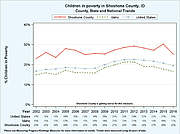Measuring up 2017: Part 1
Shoshone County’s combined high school graduation rate of 89 percent continues to be strong and out-pace the state average of 79 percent ...
It’s probably best to start with a positive note when reviewing what the County Health Rankings have to say about Shoshone County; mostly because it doesn’t have much else nice to say.
Conducted by the Robert Wood Johnson Foundation (RWJF) and the University of Wisconsin Population Health Institute (UWPHI), the ninth annual report has once again ranked Shoshone County 41 out of 42 participating Idaho counties in terms of overall health. Benewah county was the only one that ranked lower, sitting in last at 42.
For those who know that Idaho has 44 counties, not 42, population health analyst at the University of Wisconsin, Anne Roubal, explained that “Clark and Camas counties are unranked, because we did not receive values of premature death for these counties.”
This unchanged placing from last year doesn’t necessarily imply that nothing has gotten better. In fact, many categories that Shoshone County ranked poorly in on the 2016 report made slight improvements. These were off-set though by many other categories that got worse.
The county rankings are determined based on summary composite scores in two main categories that are calculated from sub-categories and individual measures (policies or programs).
The Health Outcomes main category (accounts for 50 percent of the overall score) is ranked based on scores in two sub-categories which are Length of Life (50 percent) and Quality of Life (50 percent). The Health Factors main category (accounts for the other 50 percent of the overall score) is slightly more complex, as it is determined by the rankings of four sub-categories which are Health Behaviors (30 percent), Clinical Care (20 percent), Social & Economic Factors (40 percent), and Physical Environment (10 percent).
The final scores of the categories are then compared to the other counties so they can all be ranked.
Similar to the 2016 rankings, the report shows that several of the measures that determine sub-category rankings classify as “areas to explore” or need to be worked on.
Regarding the main category of Health Outcomes for Shoshone County, its overall rank of 41 out of 42 Idaho counties is largely influenced by the Length of Life sub-category, which also sits at 41. The County’s number of years of potential life lost before the age of 75 per 100,000 in the population sits at a high 11,000 (compared to the state average of 6,300) and was the main reason for the poor Length of Life mark.
Quality of Life (26 out of 42 Idaho Counties) measures on the other hand stood up to state averages much better than Length of Life, but were still slightly above or at them.
On the Health Factor main category side of things (40 out of 42), Shoshone County took hard hits in Social & Economic Factors (42 out of 42) and Health Behaviors (34 out of 42) sub-categories. The report identified four of the nine measures in Social & Economic Factors as areas to explore. These poor measures included a high unemployment rate (7.3 percent compared to the state average of 3.8 percent), number of injury related deaths per 100,000 in the population (132 compared to 71), number of reported violent crimes per 100,000 in the population (353 compared to 212) and percentage of children in poverty (25 percent compared to 17 percent).
A strong graduation rate in this sub-category was not enough to offset the other poor scores.
Health Behaviors also showed four measures that are classified as areas to explore. Although they have improved from last year, the percentage of physically inactive adults (25 percent compared to 20 percent) and obese adults (30 percent compared to 29 percent) remains high. The percentage of adult smokers (16 percent compared to 14 percent), the number of newly diagnosed chlamydia cases per 100,000 in the population (419.7 compared to 344.5) and a glaring percentage of alcohol-impaired driving deaths (52 percent compared to 32 percent) also brings the ranking down.
Ironically, Shoshone County does show positive numbers in the percentage of adults with access to exercise opportunities (93 percent compared to 80 percent) and percentage of adults that excessively drink (14 percent compared to 17 percent).
Clinical Care (24 out of 42) and Physical Environment (18 out of 42) were some of the only sub-categories where positive measure numbers outweighed (or came close to outweighing) the negatives.
A low percentage of the population under 65 without health insurance (13 percent compared to 13 percent) and low number of preventable hospital stays (35 compared to 32) keeps Shoshone County’s Clinical Care ranking in the middle of the pack. These positive statistics are countered by an ugly ratio of the population with access to a primary care physician (3,110:1 compared to 1,560:1) and a low percentage of female Medicare enrollees ages 67-69 that receive mammography screenings (44 percent compared to 58 percent).
Shoshone County’s best sub-category, Physical Environment, benefits greatly from a low daily density of fine particulate matter (6.6 micrograms per cubic meter compared to 7.2) and a lower than average percentage of workers who drive alone and have a long commute to work (18 percent compared to 22 percent). The only measure that hurts this sub-category is the confirmation of drinking water violations.
To see the full report, visit www.countyhealthrankings.org and search for Shoshone County.
• • •
Keep an eye out for Part 2 of this article in the Wednesday, April 11 edition where the News-Press receives comment on these statistics from local officials.





